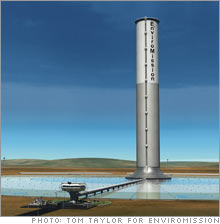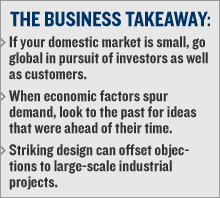How Australia got hot for solar power Down under, they're all over alternative energy - starting with a 1,600-foot-tall "solar tower" that can power a small city.
SAN FRANCISCO (Business 2.0 Magazine) -- The editors have identified the Best business ideas in the world, which will appear here in a series throughout the next month. Check back daily for updates. Rattling down a red dirt road on the edge of the Australian outback, Roger Davey hits the brakes and hops out of a rented Corolla. With a sweep of his arm, he surveys his domain - 24,000 acres of emptiness stretching toward the horizon, the landscape bare but for clumps of scrubby eucalyptus trees and an occasional sheep.
It's a dead-calm antipodean winter's day, the silence of this vast ranch called Tapio Station broken only by the cry of a currawong bird. Davey, chief executive of Melbourne renewable-energy company EnviroMission, aims to break ground here early next year on the world's first commercial "solar tower" power station. "The tower will be over there," Davey says, pointing to a spot a mile distant where a 1,600-foot structure will rise from the ocher-colored earth. Picture a 260-foot-diameter cylinder taller than the Sears Tower encircled by a two-mile-diameter transparent canopy at ground level. About 8 feet tall at the perimeter, where Davey has his feet planted, the solar collector will gradually slope up to a height of 50 to 60 feet at the tower's base. Acting as a giant greenhouse, the solar collector will superheat the air with radiation from the sun. Hot air rises, naturally, and the tower will operate as a giant vacuum. As the air is sucked into the tower, it will produce wind to power an array of turbine generators clustered around the structure. The result: enough clean, green electricity to power some 100,000 homes without producing a particle of pollution or a wisp of planet-warming gases. "We're aiming to be competitive with the coal people," says Davey, 60. "We're filling a gap in the renewable-energy market that has never been able to be filled before." And although its final dimensions are still being tweaked, the 50-megawatt Tapio Station plant is just the small model: A half-mile-tall version is in the works for China, and EnviroMission is scouting sites in the American Southwest for other possible skyscraping power plants. Tower of power The solar tower is the most audacious of a host of renewable-energy projects under way in Australia that are making the country the global hotbed of alternative-energy entrepreneurship. Among the sea of slick suits crowding the Qantas Club at Melbourne Airport just after dawn on a clear June morning, Davey, stands out in his brown-checked sports jacket. EnviroMission communications director Kim Forté leans over and whispers to Davey; she thinks she spots a familiar face amid the preflight caffeinating: a government bureaucrat involved in dispensing $370 million to low-emission energy projects. EnviroMission has applied for a $75 million piece of that pie, and a decision is imminent. It's a crucial time in Davey's eight-year quest to turn the space-age images on EnviroMission's website into steel and glass. Secure the cash from the feds and a third of the cost of the solar tower's construction is in the bank. That in turn will likely open the wallets of Australian investment banks. So today Davey and Forté are taking a 36-seater prop plane to Mildura - "Gateway to the Outback" - to rally support in the rural towns near the tower site. Energy without the mess With a solar tower, there's no fuel to dig out of the ground, transport, or dispose of, no smog, no scarred landscapes from open-pit mining. The sun rises every day and is not subject to embargoes, geopolitics, or commodity markets. And once the solar tower's capital costs are paid off, the price of producing electricity should drop dramatically, as operating and maintenance costs are expected to be minimal. Despite its monolithic scale, the technology behind the tower is based on an elemental scientific truth: Hot air rises. The solar tower's only moving parts are its turbines. Davey's mobile phone trills. "Hello? Yes, mate. 2:30 at your office. Done. Thanks, mate." On the line was an executive with AGL, one of Australia's largest utilities. Early on, EnviroMission locked up a deal to provide AGL with electricity produced by the solar tower. Davey has also secured the services of Macquarie Bank, one of the country's most prominent investment banks and a financier of major infrastructure projects in Australia and overseas. In 2002 executives at Xiang Jiang Industrial, a Shanghai developer and construction company, stumbled across press mentions of Davey's project. Xiang Jiang subsequently became EnviroMission's second-largest shareholder and has created a joint venture with the company to build and operate solar towers in China. At some point, almost everyone who comes across Davey and his tower ends up asking the same question: Is this for real? As far as Davey has come in his quest, many hurdles do remain. But out at Tapio Station, Davey insists that the solar tower will be built whether or not the government gives EnviroMission $75 million. "This used to be a dream," he says, staring out at the horizon where the tower will rise. "Then it became a concept. Now it's becoming reality." ____________________________________________ This is an excerpt from a longer story in Business 2.0's August issue. Click here to read the complete version. |
Sponsors
| |||||||||||||||||||||


